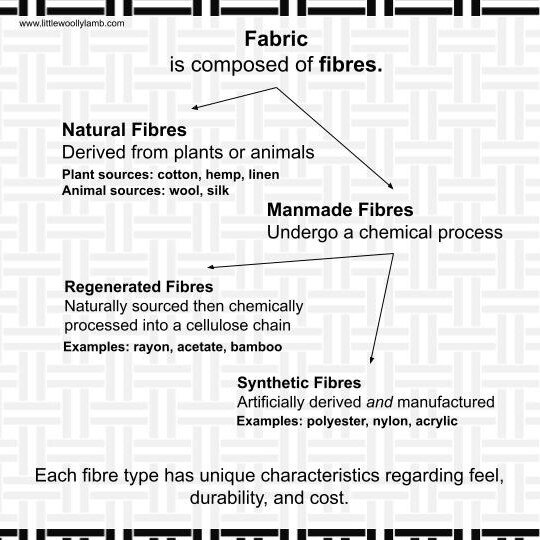An Introduction to Fabric in 3 Infographics
I have a long-term goal of learning how to make clothes and work with patterns. I figured that the best way to progress with this goal is to start with the basics and challenge myself in incremental ways. It was serendipitous then, when the Love to Sew podcast, on break until March 2021, re-posted an episode from 2018 all about fabric. The information in these photos and photo captions is sourced from:
Love to Sew Podcast. Episode 27: Fabrics 101. Originally aired 2018 February 5. Hosted by Helen Wilkinson and Caroline Somos. Link.
The biggest takeaway from this episode is the distinction between the construction of the fabric and the contents of the fabric. There was tons of information in this episode, including a bit on brand names and the history of certain materials, which is not summarized here. If you’re looking for a few quick infographics with some basic info, keep scrolling.
While listening, I did a quick check of Wikipedia for the following supplemental information:
Fabric is made up of thread or yarn assembled together to make a fabric (in these photos I use the word “fibre”)
Warp threads run longitudinally and are secured at both ends (to a loom) to keep tension. There are many pieces or units of warp thread
Weft is continuous length of fabric that moves horizontally across the warp threads
Image credits: All background photos sourced from Pixabay. Photo 1 and 2 credited to DavidZydd. Infographics made by Jessica Lam.
Photo 1: Fabric is Composed of Fibres
Fabric is made up of many fibres. These fibres can be sourced for a variety of places and fall into two main categories. The first is natural fibres. Natural fibres are derived from animal or plant sources. Plant sources include cotton, hemp, and linen. Animal sources include wool and silk. The second category of fibre is manmade fibres, which undergo some chemical processing. The man made fibre category is further broken down into two groups. Regenerated fibres have a natural source but undergo a chemical process in order to make them into a fibre. Examples of regenerated fibres are rayon, acetate, and bamboo. The second group within the manmade fibre category are synthetic fibres. These are artificially derived and manufactured. Examples of synthetic fibres are polyester, nylon, and acrylic.
The background of photo 1 is an illustration of a weave. It is a visual representation of woven fabric, constructed from carefully crossed fibres.
Photo 2: Fibres can be assembled in different ways
The fibres in a fabric can be constructed together in a variety of ways. Woven fabric are made when one long fibre, called the weft, is made to run past a series of fibres running in another direction, called the warp. There are different ways to weave fabric, including woven twill (used for denim), plain, and satin twill. Knit fabric is a series of connected loops, or a chain. The last type of fabric is fused fabric. Fused fabrics consist of a base layer that is processed with heat, water, and friction. Examples of fused fabrics include felt, melton, and synthetic leather.
The background of photo 2 is an illustration of interconnected loops. It is a visual representation of knit fabric, composed of chains of loops.
Photo 3: Characteristics are Determined by Composition and Construction
The qualities of a fabric are determined by the combination of the fibre type and the method of assembly. Another way to say it is, the composition of the fabric (natural or manmade) and the way it is constructed (woven, knit, fused) determine a fabric's characteristics. There are many ways to characterize or describe fabric. This photo describes three, including drape, or how the fabric falls. Some words used to describe drape could include “fluid” or “stuff”. Another way to describe fabric is its weight. Commonly measured in grams per square metre, weight is not a measurement of a fabric’s opacity or thickness.
Another property of fabric, and the last one described on this photo is stretch. Stretch refers to how a fabric extends but also how it recovers or relaxes. The higher the spandex content, the higher the recovery and recovery is necessary to have clothes keep their shape. There are two common measurements for stretch. A garment label will indicate the percentage of spandex in a garment, indicating what proportion of fibres are spandex.. Stretch percentage (or percentage of stretch) is how much the fabric stretches. It can be measured quite simply using a ruler and a known amount of fabric. The maximum length you can pull is used to calculate the stretch percentage: Stretch % =original lengthmaximum length 100.
Regarding photo 3, the top background photo of jute, a woven fabric made of natural fibres. The bottom photo is knit yarn, chosen because of the clearly delineated loops of fibre.
Podcasts are one of my favourite forms of media. A big shout out to Helen and Caroline from Love to Sew for providing tons of valuable information and resources to makers everywhere. Including this one who wrote this blog post.


